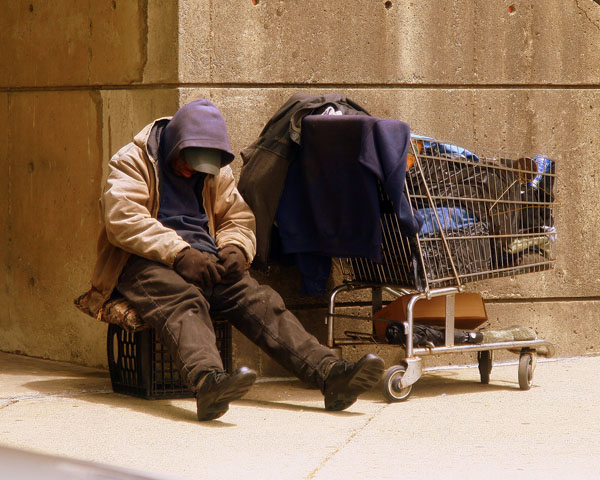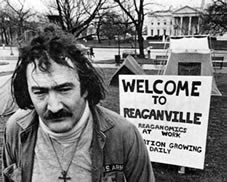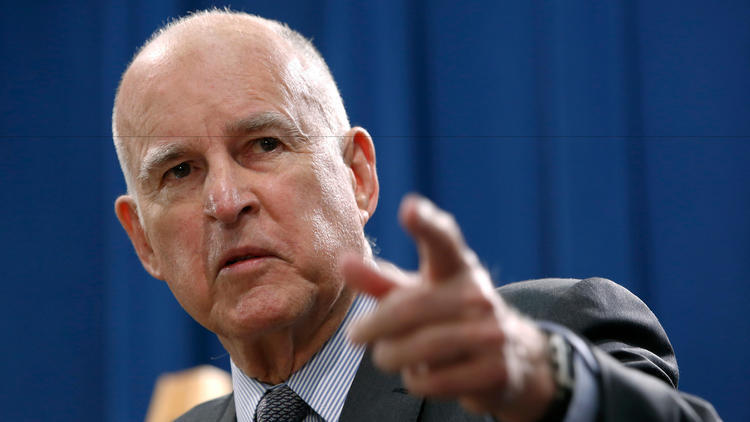A few days ago, I saw that Governor Jerry Brown had signed a bill granting 2 billion dollars to building housing for homeless folks.
I have two concerns with this legislation. First is the optics. The Governor’s approval of this bill says that “fleece the rich and give to the poor” is a moral action of the government. He is using class envy and homelessness for his political advantage. Second, the numbers used in the discussion of mentally ill homeless folks are seldom analyzed in a critical manner.
Here is the first paragraph of the story that I wish to discuss.
The measure allows the state to sell bonds for homeless shelters and repay the debt with money from a 2004 voter-approved tax on millionaires.
Link: Brown approves 2 billion to house mentally ill homeless

For those of you that are low information voters, the 2004 voter approved tax on millionaires (Prop 63) is about to expire. It is up for renewal on the November 2016 ballot. Brown’s press release about signing the bill is political propaganda on display. Brown needs that tax to stay so Democrats can continue their spending binge.
Why does the state need to sell bonds for this when the tax has yielded billions to the state? Why not pay cash?
Thus far, the state of California has collected 14. 65 billion under this tax. Prop 63 now accounts for 24 percent of the State’s mental health budget.
Link: MHSOAC History
Is Prop 63 effective?
But beyond anecdotal examples, there is no common data pool to show how the money raised is being spent and if it is making a dent in the state’s mental health crisis, according to the commission.
Link: Impact of millionaire tax to fund mental health care still hard to gauge
Despite all the money being spent, institutional care is almost nonexistent.
The California Hospital Association says 20,000 people sought treatment for mental illness in county hospitals last year. John Boyd is with Sutter Solano Medical Center.
“It’s not the right place,” he says. “Many communities throughout the state have open crisis stabilization units or psych emergency rooms and in those cases, people go to an environment that’s designed to provide the kind of specialized care that they need and that they benefit from in both the short and the long term. Sacramento closed that back in 2009.”
When looking at the issue of homelessness, many numbers just don’t make sense.
Legislative analysts expect the measure to fund at least 14,000 units. Federal housing officials estimate more than 29,000 homeless Californians were living with serious mental illness in 2015.
Link: Brown approves 2 billion to house mentally ill homeless
Here is our first math fact. Per the above story, 29,000 homeless Californians have mental illness.
An estimated 26% of homeless adults staying in shelters live with serious mental illness and an estimated 46% live with severe mental illness and/or substance use disorders.
Our second math fact is from the National Alliance on Mental Health. 26 percent of those in shelters and 46 percent of all homeless have mental health and/or substance abuse disorders.
Ok, using the above numbers:
29,000 divided by 46 percent is 63,000 homeless in California.
California has one third of all welfare cases in the United States (because we pay more in benefits than other states) it would seem logical that we would have a large share of mentally ill also.
2 billion divided by 14,000 is $142,857.14 per homeless person.
Remember, this isn’t total expenditures on the homeless, this is just one program.
There are an array of government and private assistance to the homeless. Plus homeless can get welfare and SSI payments each month.
When it comes to the mentally ill, lots gets spent every year but the State has nothing to show for it. Government only has one solution for failure: more programs and more money are required. Some of these folks need to be in institutions but there aren’t any. And this brings us to my second issue.
A Brief History of Homelessness
Governor Jerry Brown has a history with mental illness issues. No, not because he was called “moonbeam” when he was previously governor. Much of the current homeless problems lead back to his previous time as governor. Brown helped put the mentally ill on the streets. Yet somehow he gets a pass and Liberals have laid this at Ronald Reagan’s doorstep.
Below are excerpts of an article from the New York Times
In California, for example, the number of patients in state mental hospitals reached a peak of 37,500 in 1959 when Edmund G. Brown was Governor, fell to 22,000 when Ronald Reagan attained that office in 1967, and continued to decline under his administration and that of his successor, Edmund G. Brown Jr.
One of the most influential groups in bringing about the new national policy was the Joint Commission on Mental Illness and Health, an independent body set up by Congress in 1955. One of its two surviving members, Dr. M. Brewster Smith, a University of California psychologist who served as vice president, said the commission took the direction it did because of ‘‘the sort of overselling that happens in almost every interchange between science and government.’’
‘‘Extravagant claims were made for the benefits of shifting from state hospitals to community clinics,’’ Dr. Smith said. ‘‘The professional community made mistakes and was overly optimistic, but the political community wanted to save money.’‘
Charles Schlaifer, a New York advertising executive who served as secretary-treasurer of the group, said he was now disgusted with the advice presented by leading psychiatrists of that day. ‘‘Tranquilizers became the panacea for the mentally ill,’’ he said. ‘‘The state programs were buying them by the carload, sending the drugged patients back to the community and the psychiatrists never tried to stop this. Local mental health centers were going to be the greatest thing going, but no one wanted to think it through.’‘
Dr. Bertram S. Brown, a psychiatrist and Federal official who was instrumental in shaping the community center legislation in 1963, agreed that Presidents Eisenhower, Kennedy and Johnson were to some extent misled by the mental health community and Government bureaucrats.
But, he continued, ‘‘It happened much faster than we foresaw.’’ The discharge of mental patients was accelerated in the late 1960’s and early 1970’s in some states as a result of a series of court decisions that limited the commitment powers of state and local officials.
Starting in the 1960s, there has been a worldwide trend toward moving psychiatric patients from hospital settings to less restricting settings in the community, a shift known as “deinstitutionalization.” Because the shift was typically not accompanied by a commensurate development of community-based services, critics say that deinstitutionalization has led to large numbers of people who would once have been inpatients being incarcerated in jails and prisons or becoming homeless.
Link: Involuntary commitment
OK so what was happening was in the 1960’s was two different movements were developing that both were focused on reversing the institutionalization of the mentally ill.
Government
The federal government was leading the charge to move patients from state hospitals to community clinics. The effort was at the behest of the mental health community. Reducing government’s expenditures and better drugs for patients were factors in this decision.
ACLU
At the same time the community clinic idea is gaining political momentum, the ACLU and likeminded folks were filing legal actions to stop involuntary commitment of the mentally ill.
Mental hospitals in the early 20th Century were much influenced by the Eugenics movement. Practices such as forced sterilization were widespread. By the 1960’s, they had a reputation as sewers where the unwanted were dumped and warehoused. Their reputation was so bad that people wanted to find an alternative.
One person on Democrat Underground described it this way:
Left “reformers” and right ‘budget cutters” came together and deinstitutionalized patients in mental hospitals held against their will. Left-wing reformers who thought they were protecting the “rights” of mental patients teamed up with right-wing libertarians to discharge patients.
There were many cases of people charging that they were being held against their will and reports of severe abuse and inhumane treatment in large facilities.
There isn’t much the family of a mentally ill person can do to get treatment for someone who refuses it because at least half the states forbid involuntary treatment unless the patient is an immediate danger to himself or others. Many mental illnesses, particularly schizophrenia and bipolar disorder, prevent the sufferer from perceiving that he is ill or in need of treatment.
The charge from the left was people were being “jailed” for no good reason and for plenty of bad ones, including discrimination, family retribution and so forth.
There is no easy solution to this, some people will refuse treatment and what mechanism should be in place to protect people from unfairly being held against their will?
Link: Democrat Underground Discussion #10
At the same time that the government was moving to a community clinic model, civil libertarians were creating rights for the mentally ill not to be institutionalized.
I know that there was (is?) a movement on the part of civil libertarians (ACLU, etc..) that wanted to halt the practice of institutionalizing people against their will. They felt that this practice was at odds with the concept of a free society. There comes a point were even a mentally ill person has a right to refuse treatment against his or her will.
Link: Democrat Underground Discussion #2
Please note that it was a combination of Democrat leadership including: the President, Congress and California Governor Pat Brown that started this migration from state run facilities to local ones here in California. This practice was continued under both Ronald Reagan and Pat’s son, Jerry. Reagan tried to move the system from state run to a publicly funded partnership with private companies.
The paragraph from the New York Times needs to be mentioned again.
In California, for example, the number of patients in state mental hospitals reached a peak of 37,500 in 1959 when Edmund G. Brown was Governor, fell to 22,000 when Ronald Reagan attained that office in 1967, and continued to decline under his administration and that of his successor, Edmund G. Brown Jr.
So under the eight years that Pat Brown was Governor, the mental hospital population went from 37,500 to 22,000. This is a 41 percent decrease. Over the next 16 years, the population under Reagan and Brown Jr. declined to the point where the hospital system was no longer financially viable.
Jerry Brown did nothing to reverse the policies of his father. In fact, he was forced to release virtually the entire population onto the streets.
The final nail in the coffin of the mental hospital system was the June 26, 1975 U.S. Supreme Court ruling in O’Connor v. Donaldson.
O’Connor v. Donaldson, 422 U.S. 563 (1975), was a landmark decision in mental health law. The United States Supreme Court ruled that a state cannot constitutionally confine a non-dangerous individual who is capable of surviving safely in freedom by themselves or with the help of willing and responsible family members or friends. Since the trial court jury found, upon ample evidence, that petitioner did so confine respondent, the Supreme Court upheld the trial court’s conclusion that petitioner had violated respondent’s right to liberty.
Link: O’Connor v. Donaldson
In this case, the majority found no constitutional grounds for most confinement:
May the State confine the mentally ill merely to ensure them a living standard superior to that they enjoy in the private community? That the State has a proper interest in providing care and assistance to the unfortunate goes without saying. But the mere presence of mental illness does not disqualify a person from preferring his home to the comforts of an institution. Moreover, while the State may arguably confine a person to save him from harm, incarceration is rarely if ever a necessary condition for raising the living standards of those capable of surviving safely in freedom, on their own or with the help of family or friends.
May the State fence in the harmless mentally ill solely to save its citizens from exposure to those whose ways are different? One might as well ask if the State, to avoid public unease, could incarcerate all who are physically unattractive or socially eccentric. Mere public intolerance or animosity cannot constitutionally justify the deprivation of a person’s physical liberty.
In short, a State cannot constitutionally confine without more a non-dangerous individual who is capable of surviving safely in freedom by himself or with the help of willing and responsible family members or friends.
Writing for the majority—Associate Justice Potter Stewart
Link: Caselaw O’Connor v. Donaldson
The Supreme Court decision was in the first year of Jerry Brown’s administration. Brown had seven years to create an alternative system but did nothing. The only thing left after the court decision was the local clinics and that is what he went with.
Brown could have created some sort of sanctuary system so those turned out on the streets had places to go. If this was a voluntary system then it would not conflict with the Supreme Court ruling. Instead communities enacted no loitering and vagrancy statutes. Homeless camps are periodically razed by law enforcement and public health officials. There is no safe place for the homeless. Some communities have shelters for sleeping at night but many of these are only open in the winter.
I don’t believe that anyone has a complete solution but giving many a safe place to call their own with a laundry, bathing facilities, mailbox and a small storage area would seem helpful.
Perhaps no politician wants the tag of “Hooverville” attached to their legacy so they never tried this approach. I know that private citizens who have wanted it have been rebuffed by local government. Maybe the logistics of policing such an area are too difficult under modern theories of how law enforcement should work. Perhaps many of these folks just don’t want any one telling them what to do.
One thing life has taught me is that some people would rather be homeless than live under rules: any rules. This is freedom to them. Bob Dylan had it right when in 1980 he said, “You gotta serve somebody”. If you don’t, this is how low you have to go to escape in our society.
Clearly, after a century of trying, the government is ill equipped to deal effectively with the mentally ill.
Lastly, before closing this topic, I wish to circle once again back to the number of homeless.
The final part of this blog is an examination of population.
Many mentally ill people were let loose as a result of O’Connor v. Donaldson. The numbers grew thru the rest of the 1970’s and into the 1980’s. In the 1980’s, Mitch Snyder, was going around the country claiming that the homeless population was three million people. Snyder was proclaiming that this was a crisis. Many media outlets latched on to this issue as a way to attack the policies of President Ronald Reagan.
Snyder’s campaign was effective and he was able to get more government funding for shelters—even though most of what he said was based on a series of lies that were willingly parroted by the media.

Ultimately, when Snyder was pressed on his figure of 3 million homeless, he admitted that it was a fabrication. Journalists had been hounding him for a specific number, he said, and he hadn’t wanted them to walk away empty-handed.
Link: Seattle Central
A statistical analysis of the available data for the 1980’s has found that the national homeless population varied between a low of 200,000 and a high of 400,000—depending on which year and statistical model that you use.
Link: Homelessness Paper See Table 4
Despite increases in the general population, the number of homeless folks has not increased accordingly. There is a steady base of people—many enslaved by drugs and alcohol, while others enter and leave homelessness. It is not a permanent condition or station in life for all.
Conclusion
Governor Brown started the State’s policies on the treatment of the mentally ill homeless over 40 years ago. He and his Party have owned all the levers of power in California for many years but neither they nor their counterparts in other states have found any solutions for the homeless. Is this another instance where a Party would rather have the issue at election time than fix the problem? Or perhaps Jesus was right when he said, “For ye have the poor always with you.” Matthew 26:11 In which case it’s not a government solution that’s needed but a spiritual one.
